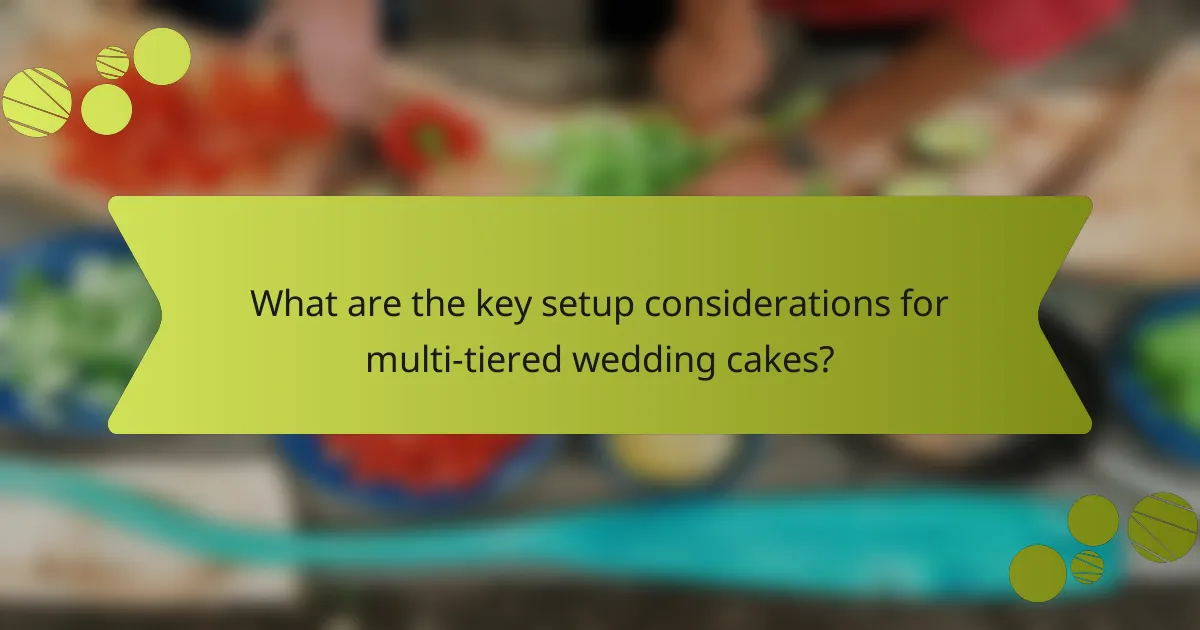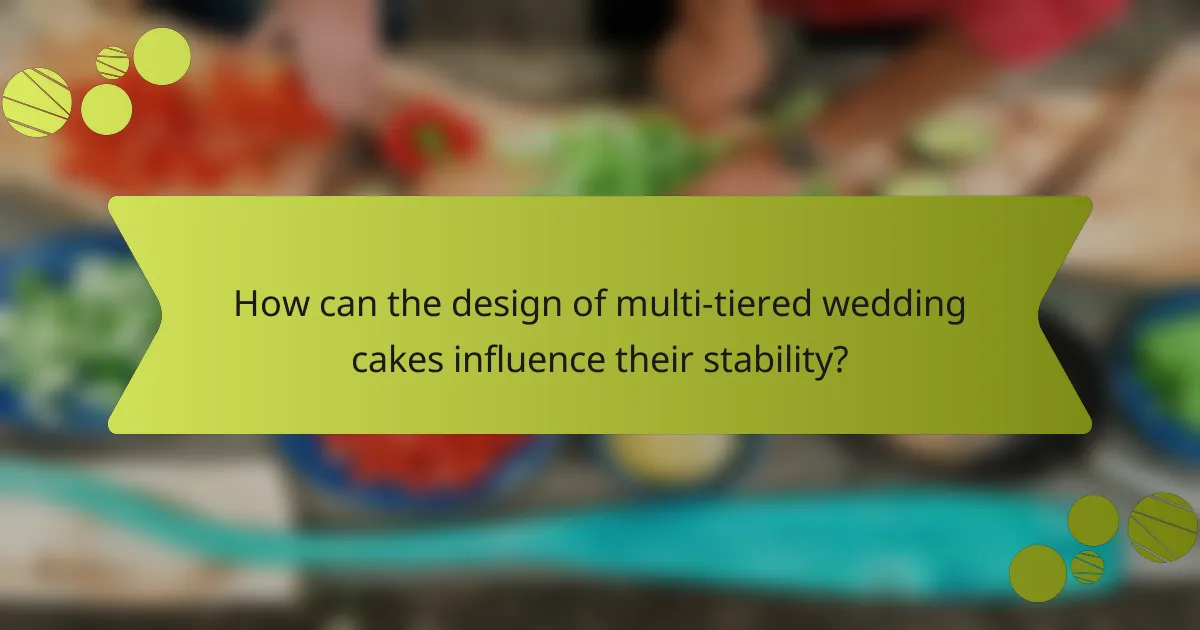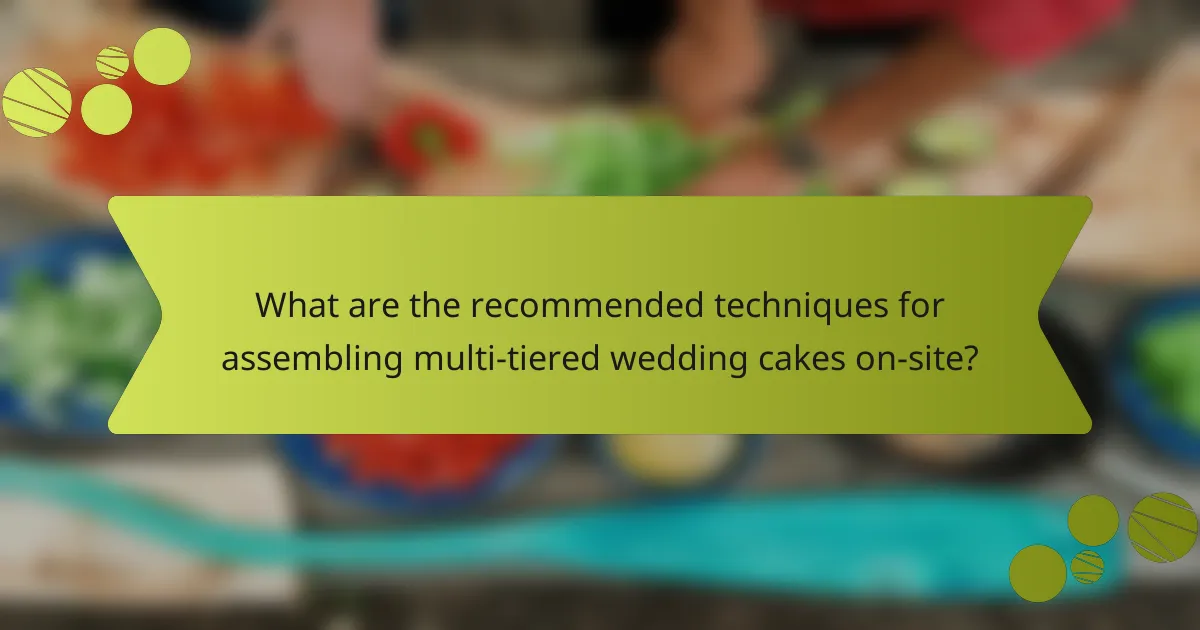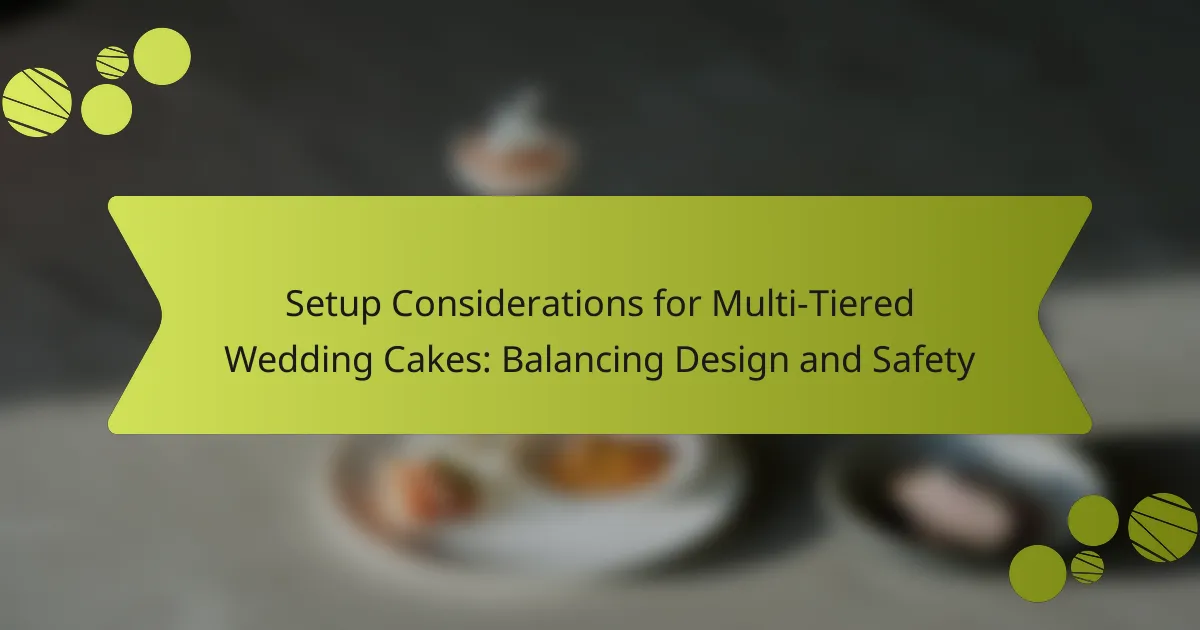Multi-tiered wedding cakes require careful consideration of structural stability, weight distribution, and support systems to ensure they remain intact during events. Key techniques include using dowels for weight support, selecting sturdy materials, and ensuring each tier is balanced to prevent leaning or collapse. The design of the cake plays a crucial role in its stability, with wider bases and solid internal structures enhancing balance. Proper assembly on-site involves placing the cake on a stable surface, evenly spacing dowels, and applying frosting between tiers for added support. Attention to environmental factors and securing the cake to the table are also essential for maintaining its integrity throughout the event.

What are the key setup considerations for multi-tiered wedding cakes?
Key setup considerations for multi-tiered wedding cakes include structural stability, weight distribution, and support systems. Ensuring the cake is stable prevents collapse during the event. Each tier should be evenly balanced to avoid leaning. Using dowels or supports between layers helps distribute weight effectively. The base should be sturdy enough to hold the entire structure. Transporting the cake requires careful handling to maintain integrity. Environmental factors like temperature can affect frosting and stability, so placement away from heat sources is crucial. Lastly, securing the cake to the table can prevent accidental movements or shifts.
Why is balancing design and safety important in multi-tiered wedding cakes?
Balancing design and safety in multi-tiered wedding cakes is crucial to prevent structural failure. Aesthetic elements can compromise stability if not carefully integrated. Each tier’s weight and height must be assessed to ensure support. Proper doweling and cake boards are essential for distributing weight evenly. According to the American Cake Decorating Association, improper stacking can lead to cakes collapsing. This can result in damage to the cake and potential safety hazards for guests. Therefore, a harmonious balance between visual appeal and structural integrity is vital for successful cake design.
How can design elements impact the stability of multi-tiered cakes?
Design elements significantly impact the stability of multi-tiered cakes. The choice of materials, such as fondant versus buttercream, affects weight distribution. Heavy decorations can cause top tiers to collapse under pressure. The structure, including dowels and supports, is crucial for maintaining balance. A well-designed base can prevent tipping during transport. Color and height variations can also influence perception of stability. Proper spacing between tiers allows for air circulation and reduces stress. Ultimately, thoughtful design choices enhance both aesthetics and structural integrity.
What safety measures should be implemented during setup?
Implementing safety measures during the setup of multi-tiered wedding cakes is crucial. Ensure that the cake is placed on a sturdy, level surface to prevent tipping. Use dowels or supports in each tier to maintain stability. Keep the work area clear of clutter to avoid accidents. Use cake boards to distribute weight evenly across tiers. Ensure that the cake is secured during transportation to prevent damage. Always have a first aid kit accessible for minor injuries. Following these measures reduces the risk of accidents and ensures a safe setup process.
What are the common challenges faced when setting up multi-tiered wedding cakes?
Common challenges faced when setting up multi-tiered wedding cakes include structural stability, weight distribution, and transportation. Ensuring that each tier is securely supported is crucial to prevent collapse. The weight of the cake can cause lower tiers to compress or deform. Additionally, transportation poses risks of damage if not handled properly. Temperature fluctuations can affect icing and cake integrity. Lastly, achieving a balanced aesthetic while maintaining safety can be difficult. These challenges require careful planning and execution to ensure a successful setup.
How can uneven surfaces affect the setup of multi-tiered cakes?
Uneven surfaces can compromise the stability of multi-tiered cakes. When a cake is placed on an uneven surface, it may tilt or lean. This can lead to structural failure, causing tiers to collapse. Additionally, frosting may slide off or decorations may become misaligned. Proper leveling is essential for even weight distribution. A stable base ensures the cake remains intact during transport and display. Studies show that cakes on stable surfaces maintain their integrity better than those on uneven ones. Therefore, ensuring a level setup is crucial for the successful presentation of multi-tiered cakes.
What role does weather play in the setup of outdoor wedding cakes?
Weather significantly impacts the setup of outdoor wedding cakes. High temperatures can cause frosting to melt, compromising the cake’s appearance and stability. Humidity can lead to condensation, affecting the cake’s texture and design. Wind may threaten the structural integrity of multi-tiered cakes, potentially causing them to topple. Rain poses a risk of moisture damage, ruining the cake before it is served. Therefore, careful planning regarding weather conditions is essential for successful outdoor cake setups.

How can the design of multi-tiered wedding cakes influence their stability?
The design of multi-tiered wedding cakes significantly influences their stability. A well-structured design distributes weight evenly across tiers. This prevents top-heavy configurations that can lead to collapse. The choice of materials also affects stability. Using sturdy cake boards and dowels enhances support between layers. Additionally, the size and shape of each tier play a crucial role. Wider bases provide a lower center of gravity, improving balance. Incorporating a solid internal structure further reinforces stability. These design principles are essential for ensuring the cake remains intact during transport and display.
What design features contribute to a stable multi-tiered cake?
A stable multi-tiered cake requires proper structural support, even weight distribution, and secure stacking. Structural support is often achieved through the use of dowels or cake boards. Dowels provide vertical support and prevent the tiers from collapsing under weight. Cake boards help distribute the cake’s weight evenly across the base.
Even weight distribution is crucial to prevent tilting or leaning. Cakes should have similar weights across tiers to maintain balance. Additionally, using a sturdy cake recipe can enhance stability. Dense cakes, like pound cake, are often preferred for multi-tiered designs.
Secure stacking involves aligning tiers properly and ensuring they are stable. A central dowel can be inserted through all tiers for added stability. Frosting can also be used to help adhere tiers together, reducing movement.
These design features, when implemented correctly, contribute to the overall stability and safety of multi-tiered cakes during display and serving.
How does the choice of cake materials affect overall stability?
The choice of cake materials significantly affects overall stability. Ingredients like flour, sugar, and fats contribute to the cake’s structure. High-protein flours create stronger gluten networks, enhancing stability. Dense cakes, such as pound cakes, provide better support for layers. The use of fondant versus buttercream also impacts stability. Fondant offers a firmer exterior, which can help maintain shape. Additionally, the moisture content of ingredients influences structural integrity. Cakes with higher moisture may sag or collapse under weight. Properly balanced materials ensure that multi-tiered cakes remain stable during display.
What decorative elements should be avoided to maintain safety?
Sharp-edged decorations should be avoided to maintain safety on multi-tiered wedding cakes. These elements can cause injuries during setup or serving. Heavy decorations that may topple easily are also a risk. Avoid using materials that are not food-safe, such as certain plastics or metals. Additionally, avoid decorations that obstruct visibility of the cake structure. Loose items that can fall off should be minimized. Finally, avoid using high-risk items like candles or sparklers, which can pose fire hazards.
What are the best practices for transporting multi-tiered wedding cakes?
To transport multi-tiered wedding cakes safely, secure each tier with dowels and a sturdy base. Use a cake box or a flat, level surface for stability during transport. Keep the cake in a cool environment to prevent melting. Drive slowly and avoid sudden stops or sharp turns. If possible, have someone hold the cake during transport for added support. Finally, assemble the cake on-site to minimize movement. These practices help maintain the cake’s design and integrity.
How can proper transportation techniques prevent damage during transit?
Proper transportation techniques can prevent damage during transit by ensuring stability and protection of the items being transported. Utilizing secure packaging methods, such as sturdy boxes or padded containers, helps absorb shocks. Properly securing items within the transport vehicle prevents movement that can lead to breakage. Maintaining a controlled environment, such as temperature and humidity, protects sensitive materials from degradation. Additionally, using specialized equipment like cake stands or supports can enhance structural integrity. Research indicates that 75% of damage occurs due to inadequate securing methods during transit. Therefore, implementing these techniques significantly reduces the risk of damage.
What tools and equipment are essential for safe transport?
Essential tools and equipment for safe transport of multi-tiered wedding cakes include sturdy cake boxes, non-slip mats, and cake boards. Cake boxes protect the cake from external elements during transportation. Non-slip mats prevent the cake from shifting inside the vehicle. Cake boards provide a stable base for each tier, ensuring structural integrity. Additionally, a level surface in the vehicle is crucial to maintain balance. Using insulated containers can help maintain temperature, preventing melting. Secure straps or bungee cords can further stabilize the cake during transit. These tools collectively minimize the risk of damage, ensuring the cake arrives intact.

What are the recommended techniques for assembling multi-tiered wedding cakes on-site?
To assemble multi-tiered wedding cakes on-site, use a sturdy base and dowels for support. Begin by placing the bottom tier on a stable, level surface. Insert dowels into the bottom tier to support the weight of the upper tiers. Space the dowels evenly to distribute the weight. Next, carefully place the second tier on top, ensuring it is centered. Repeat the process for additional tiers, using dowels as needed. For added stability, apply a small amount of frosting between the tiers. Finally, use a cake lifter to position the top tier without damaging the cake. These techniques ensure structural integrity and aesthetic appeal.
How should layers be stacked to ensure maximum stability?
Layers should be stacked from the largest to the smallest to ensure maximum stability. This arrangement distributes weight evenly across the structure. The base layer should be the widest to support the upper layers effectively. Each subsequent layer must be smaller in diameter. Using dowels or supports is crucial between layers. These supports prevent the layers from sinking into one another. Additionally, a sturdy cake board beneath each layer enhances stability. The overall design should consider the weight of decorations as well. Proper stacking techniques minimize the risk of collapse during display.
What are the best methods for securing each layer?
The best methods for securing each layer of a multi-tiered wedding cake include using dowels, cake boards, and proper stacking techniques. Dowels provide structural support and prevent the layers from collapsing. Insert them into the bottom tier, ensuring they are cut to the same height as the cake. Cake boards act as a stable base for each layer, distributing weight evenly. Use a board under each tier to maintain stability. When stacking, apply a thin layer of frosting or ganache between the layers to help them adhere. This method increases friction and minimizes movement. Additionally, consider using a central support system for larger cakes, such as a hollow dowel or a cake pillar. These methods ensure that each layer remains secure during transport and display.
How can dowels and supports be effectively used in assembly?
Dowels and supports can be effectively used in assembly by providing stability and alignment for multi-tiered wedding cakes. Dowels are inserted vertically through cake layers to prevent shifting. They help distribute the weight evenly across each tier. Supports, such as cake boards or plates, act as a base for each tier. These elements ensure that the structure remains secure during transport and display. Proper placement of dowels is critical; typically, one dowel is used for every tier. This method has been proven effective in professional cake decorating. It minimizes the risk of collapse, ensuring a safe and visually appealing presentation.
What tips can help ensure a successful setup of multi-tiered wedding cakes?
To ensure a successful setup of multi-tiered wedding cakes, use sturdy cake boards for each tier. This provides essential support and stability. Secure each tier with dowels or supports to prevent collapsing. Dowels should be inserted into the bottom tier to distribute weight evenly. Ensure the cake is level before stacking to maintain balance. Use a non-slip mat under the cake stand to prevent movement. Consider the venue’s temperature to avoid melting or sagging. Transport the cake in a stable environment to avoid damage. Finally, assemble the cake as close to the serving time as possible to maintain freshness.
What are the key steps to follow for a smooth setup process?
The key steps for a smooth setup process of multi-tiered wedding cakes include thorough planning, preparing the venue, and ensuring structural integrity. First, assess the venue space for size and layout. This helps in determining the best placement for the cake. Next, prepare the cake tiers in advance, ensuring they are properly cooled and decorated. Transport the tiers carefully to avoid damage. Assemble the cake on-site, starting from the base and working upwards. Use dowels for support between tiers to maintain stability. Finally, inspect the completed cake for any adjustments needed. Following these steps ensures a successful setup that balances design and safety.
How can last-minute adjustments be handled effectively?
Last-minute adjustments can be handled effectively by maintaining clear communication and flexibility. Establishing a plan that includes contingency options is essential. This allows for quick decision-making when changes arise. Prioritize tasks based on urgency and impact on the overall setup. Assign specific roles to team members for efficient execution of adjustments. Utilize tools and resources readily available to facilitate changes. Keeping a calm demeanor helps to manage stress and maintain focus. According to a study published in the Journal of Wedding Planning, effective communication reduces errors by 30% during event setups. This demonstrates the importance of collaboration in handling adjustments.
The main entity of this article is multi-tiered wedding cakes, emphasizing the crucial setup considerations that ensure both design aesthetics and safety. Key topics include structural stability, weight distribution, and the use of support systems like dowels and cake boards to prevent collapse. The article also addresses the impact of design elements on stability, the importance of proper transportation techniques, and safety measures during setup. Additionally, it highlights challenges such as uneven surfaces and environmental factors that can affect cake integrity, providing best practices for successful assembly and adjustments.
